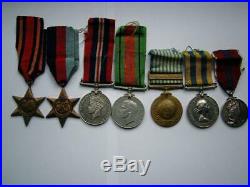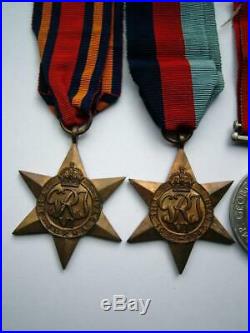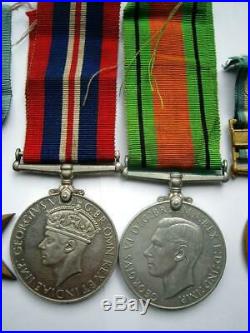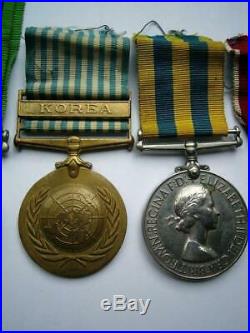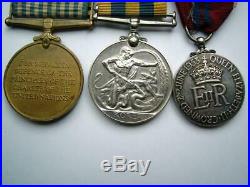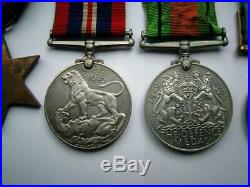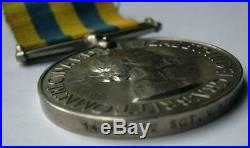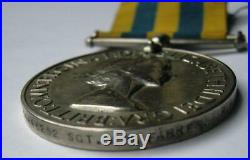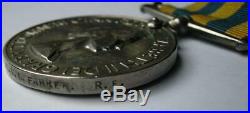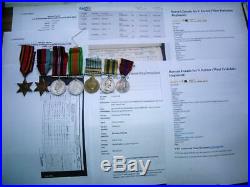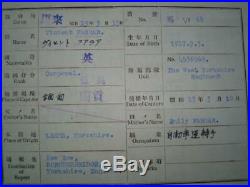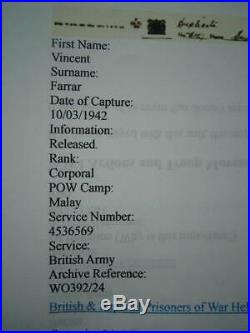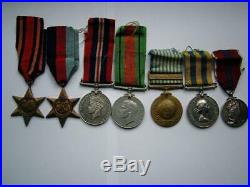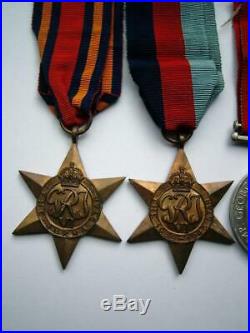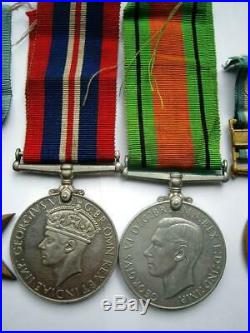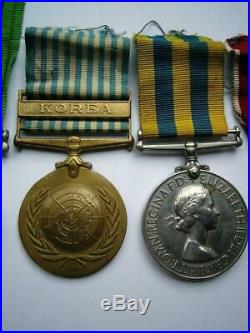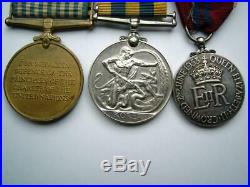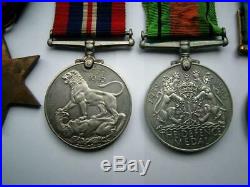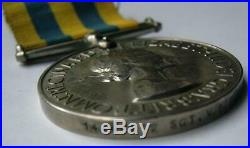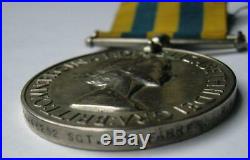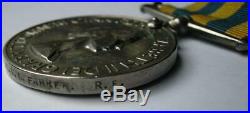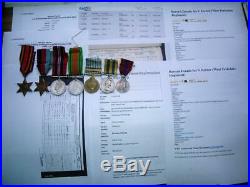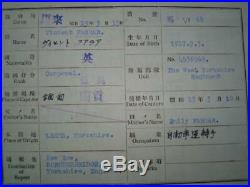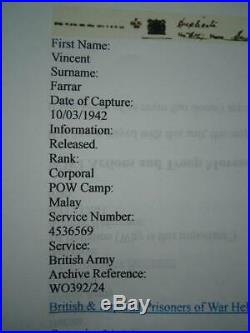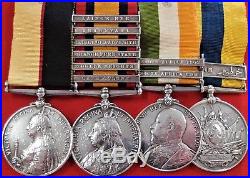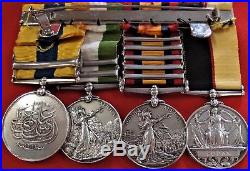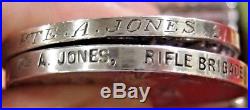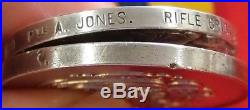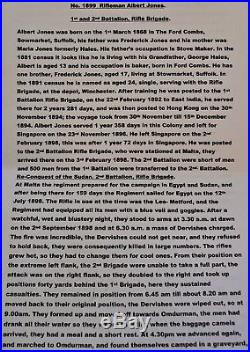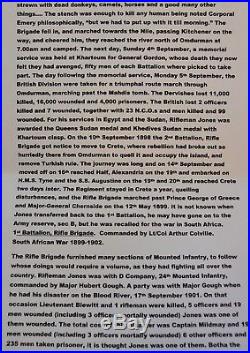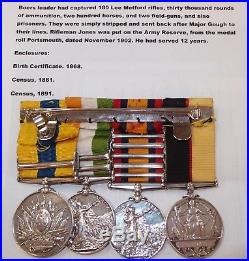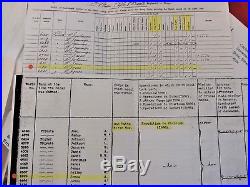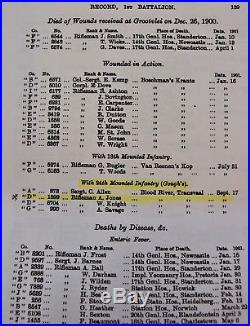Posts tagged river
WW2 1939-45 Star, Burma star, Defence and war medals 1939-45 plus 1953 Coronation, unnamed as issued. Korean war & UN medal pair 1950-53 , Korean Campaign medal official impressed 14446292 Sgt V. F” (official correction to “e in surname Farrer, surname often listed in records incorrectly as Farrar) , IMO Good Very Fine condition, signs of light use and wear, UN medal unnamed as issued. Some history included, Taken Prisoner of war in Burma by the Japanese 10th March 1942, some details copied from archives, see pictures for condition Of all the British regiments which served in Burma, none surely can equal the record of the West Yorkshires. End 1941, 1st West Yorks were moved by sea to Rangoon immediately following the outbreak of the Japanese War. Joining battle at Pegu, the battalion was constantly involved in heavy fighting throughout the terrible retreat from Burma, but gained a formidable reputation which was to remain for the rest of the war. The Brigade was constituted from the UK 28th Infantry Brigade, which had arrived in Hong Kong from the United Kingdom in 1949, to join the 40th Infantry Division. Formed in Korea in April 1951, it took the title’28th Commonwealth Brigade’ replacing 27th Commonwealth Brigade in the 1st Commonwealth Division, and served right through the war, until leaving in 1954. It comprised two British and two Australian infantry battalions and 16th Field Regiment, Royal New Zealand Artillery. WW2 Burma & Korean War medal group West Yorkshire Japanese POW Bridge River Kwai. Japanese POW WW2 & KOREAN WAR group Sergeant Vincent Farrer Royal Fusiliers late West Yorkshire Regiment. Group of seven, WW2 1939-45 Star, Burma star, Defence and war medals 1939-45 plus 1953 Coronation medal unnamed as issued. F” (official correction to “e in surname Farrer, surname often incorrectly listed as Farrar) , IMO Good Very Fine condition, signs of light use and wear, UN medal unnamed as issued. Some history included, copied from archives, see pictures for condition Corporal in West Yorkshire regiment, taken prisoner by Japanese 10th March 1942 in Burma, worked on infamous Burma railway (the “Bridge over the river Kwai”) in Korea he was with the Royal Fusiliers , IMO Good Very Fine condition, signs of light use and wear, Korean campaign medal officially impressed name, some copies of original paperwork confirming he was a prisoner of the Japanese, his service, etc, very interesting history, see pictures for condition Unusual Name, His father was 71977 Pte Charles H Farrer 10th Northumberland Regt, late 3345 Lancs & Yorks Rgt, during WW1 from August 1914, discharged due to wounds August 1918 from Northumberland Regt, Joined Royal Defence force until demobilisation April 1919. Originally from from Halifax, Yorkshire, Later father lived in Stoney Stanton, Leicestershire. Vincent Farrer born Leeds, Yorkshire 3rd September 1917, Mother Emily Farrer (Allinson), in 1940s her address was New Row, Boroughbridge, Yorkshire. He joined West Yorkshire Regiment 4536569 Private V Farrar before WW2 and probably out in India at the outbreak of war, at time of his capture his rank was Corporal. Of all the British regiments which served in Burma, none surely can equal the record of the West Yorkshires. Their fifteen Battle Honours are only exceeded by the nineteen of the 10th Gurkha Rifles (which fielded three battalions in the campaign), and the Honour Burma 1942-45, the dates covering all four years of the War, is shared only with the Royal Berkshires, 7th Gurkhas and 10th Gurkhas. Corporal Vincent Farrar was captured during the retreat from Burma to India March 1942. British troops ordered to surrender Singapore February 1942 – Disasterous decision. The Burma Railway, also known as the Death Railway, the SiamBurma Railway, the ThaiBurma Railway and similar names, was a 415-kilometre railway between Ban Pong, Thailand, and Thanbyuzayat, Burma, built by the Empire of Japan using Prisoners of war in 1942 / 1943 to support its forces in the Burma campaign of World War II. This railway completed the rail link between Bangkok, Thailand, and Rangoon, Burma. Thousands of mainly British POWs were brutalised, tortured, starved and died of exhaustion, disease or were killed by the Japanese. After the war many Japanese war Criminals were tried and punished for their crimes. Bridge over the River Kwai under construction by Japanese using British POWs. Lieutenant-Colonel Philip Toosey was the senior British officer at Tarmakan, where the Japanese forced the prisoners to construct a railway bridge over the River Kwai for the Burma-Siam Railway. The conditions at Tarmakan were appalling. 300 men were packed into each bamboo hut, with an allocation of 18 inches of space. Toosey later recalled: Every form of cruelty that an uncivilised mind could invent was used on the prisoners. British and Allied POWs of the Japanese getting water ration. He then joined the Royal Fusiliers 8th Battalion as Lance Corporal 144446292, sent to Palestine during 1945-48 prior to British withdrawal, resulting in division of Palestine and Israel. Also entited to GSM Palestine 1945-48 medal (copy medal roll extract supplied). During the next three years he was promoted up to Colour Sergeant. When in 1950, the Communist-backed forces of the North invaded South Korea, Britain became the second largest contributor out of 21 countries that joined UN forces in its first ever armed response. Yet at the time, nobody living in the rubble of post-war Britain seemed to have any appetite for another conflict. The Royal Fusiliers (City of London) were now a single Battalion and were part of the 28th Commonwealth brigade sent to fight in Korea August 1952 to July 1953, their most famous member being actor Michael Caine aka Private Maurice Micklewhite R. Even before the conflict, Korea, previously part of the Japanese Empire which had been divided by the 38th parallel between Communist North and Pro-Western South in 1945, was desparately poor. After three years of fierce fighting between Mao Tse-Tung’s Chinese and the North against the UN forces, it had been blown to pieces. The “Korean war” never really officially ended, only a “cease fire” that has held to this day. IMPORTANT NOTICE REGARDING LOCKDOWN. I will use 1st class recorded on lower value items but please be patient if your item is delayed, the post is very safe and items are tracked, thanks for understanding. Deliveries to China, Russian Federation, Australia and New Zealand are particularly bad due to closure of boarders, many items posted during Lockdown in these countries have been held in the UK waiting to be booked on to first available flight. Social distancing rules, staff shortages etc mean delays can be excessive, but post is in the system, quite safe and getting through eventually. The situation will improve over the next few weeks. Lockdown is being eased now in Australia and New Zealand with flights with Etihad and Emirates resuming 21st May onward and many more airlines restarting services during June. Thankyou for your patience and understanding during these strange times, stay safe and well. Create your brand with Auctiva’s. Track Page Views With. Auctiva’s FREE Counter. The item “WW2 Burma & Korean War medal group West Yorkshire Japanese POW Bridge River Kwai” is in sale since Sunday, April 26, 2020. This item is in the category “Collectables\Militaria\1946-1960″. The seller is “theonlineauctionsale” and is located in England. This item can be shipped worldwide.
- Country/Region of Manufacture: United Kingdom
- Country/ Organization: Great Britain
- Issued/ Not-Issued: Issued
- Type: Medals & Ribbons
- Conflict: World War II (1939-1945) / Korea 1952
- Service: Army
- Era: 1945-Present
WW2 1939-45 Star, Burma star, Defence and war medals 1939-45 plus 1953 Coronation, unnamed as issued. Korean war & UN medal pair 1950-53 , Korean Campaign medal official impressed 14446292 Sgt V. F” (official correction to “e in surname Farrer, surname often listed in records incorrectly as Farrar) , IMO Good Very Fine condition, signs of light use and wear, UN medal unnamed as issued. Some history included, Taken Prisoner of war in Burma by the Japanese 10th March 1942, some details copied from archives, see pictures for condition Of all the British regiments which served in Burma, none surely can equal the record of the West Yorkshires. End 1941, 1st West Yorks were moved by sea to Rangoon immediately following the outbreak of the Japanese War. Joining battle at Pegu, the battalion was constantly involved in heavy fighting throughout the terrible retreat from Burma, but gained a formidable reputation which was to remain for the rest of the war. The Brigade was constituted from the UK 28th Infantry Brigade, which had arrived in Hong Kong from the United Kingdom in 1949, to join the 40th Infantry Division. Formed in Korea in April 1951, it took the title’28th Commonwealth Brigade’ replacing 27th Commonwealth Brigade in the 1st Commonwealth Division, and served right through the war, until leaving in 1954. It comprised two British and two Australian infantry battalions and 16th Field Regiment, Royal New Zealand Artillery. WW2 Burma & Korean War medal group West Yorkshire Japanese POW Bridge River Kwai. Japanese POW WW2 & KOREAN WAR group Sergeant Vincent Farrer Royal Fusiliers late West Yorkshire Regiment. Group of seven, WW2 1939-45 Star, Burma star, Defence and war medals 1939-45 plus 1953 Coronation medal unnamed as issued. F” (official correction to “e in surname Farrer, surname often incorrectly listed as Farrar) , IMO Good Very Fine condition, signs of light use and wear, UN medal unnamed as issued. Some history included, copied from archives, see pictures for condition. Unusual Name, His father was 71977 Pte Charles H Farrer 10th Northumberland Regt, late 3345 Lancs & Yorks Rgt, during WW1 from August 1914, discharged due to wounds August 1918 from Northumberland Regt, Joined Royal Defence force until demobilisation April 1919. Originally from from Halifax, Yorkshire, Later father lived in Stoney Stanton, Leicestershire. Vincent Farrer born Leeds, Yorkshire 3rd September 1917, Mother Emily Farrer (Allinson), in 1940s her address was New Row, Boroughbridge, Yorkshire. He joined West Yorkshire Regiment 4536569 Private V Farrar before WW2 and probably out in India at the outbreak of war, at time of his capture his rank was Corporal. Of all the British regiments which served in Burma, none surely can equal the record of the West Yorkshires. Their fifteen Battle Honours are only exceeded by the nineteen of the 10th Gurkha Rifles (which fielded three battalions in the campaign), and the Honour Burma 1942-45, the dates covering all four years of the War, is shared only with the Royal Berkshires, 7th Gurkhas and 10th Gurkhas. Corporal Vincent Farrar was captured during the retreat from Burma to India March 1942. British troops ordered to surrender Singapore February 1942 – Disasterous decision. The Burma Railway, also known as the Death Railway, the SiamBurma Railway, the ThaiBurma Railway and similar names, was a 415-kilometre railway between Ban Pong, Thailand, and Thanbyuzayat, Burma, built by the Empire of Japan using Prisoners of war in 1942 / 1943 to support its forces in the Burma campaign of World War II. This railway completed the rail link between Bangkok, Thailand, and Rangoon, Burma. Thousands of mainly British POWs were brutalised, tortured, starved and died of exhaustion, disease or were killed by the Japanese. After the war many Japanese war Criminals were tried and punished for their crimes. Bridge over the River Kwai under construction by Japanese using British POWs. Toosey was the senior British officer at Tarmakan, where the Japanese forced the prisoners to. Construct a railway bridge over the River Kwai for the Burma-Siam Railway. 300 men were packed into each bamboo hut, with an. Allocation of 18 inches of space. Toosey later recalled: Every form of cruelty that an uncivilised mind. Could invent was used on the prisoners. British and Allied POWs of the Japanese getting water ration. He then joined the Royal Fusiliers 8th Battalion as Lance Corporal 144446292, sent to Palestine during 1945-48 prior to British withdrawl, resulting in division of Palestine and Israel. Also entited to GSM Palestine 1945-48 medal (copy medal roll extract supplied). During the next three years he was promoted up to Colour Sergeant. When in 1950, the Communist-backed forces of the North invaded South Korea, Britain became the second largest contributor out of 21 countries that joined UN forces in its first ever armed response. Yet at the time, nobody living in the rubble of post-war Britain seemed to have any appetite for another conflict. The Royal Fusiliers (City of London) were now a single Battalion and were part of the 28th Commonwealth brigade sent to fight in Korea August 1952 to July 1953, their most famous member being actor Michael Caine aka Private Maurice Micklewhite R. Even before the conflict, Korea, previously part of the Japanese Empire which had been divided by the 38th parallel between Communist North and Pro-Western South in 1945, was desparately poor. After three years of fierce fighting between Mao Tse-Tung’s Chinese and the North against the UN forces, it had been blown to pieces. The “Korean war” never really officially ended, only a “cease fire” that has held to this day. Create your brand with Auctiva’s. Track Page Views With. Auctiva’s FREE Counter. The item “WW2 Burma & Korean War medal group West Yorkshire Japanese POW Bridge River Kwai” is in sale since Tuesday, March 17, 2020. This item is in the category “Collectables\Militaria\1946-1960″. The seller is “theonlineauctionsale” and is located in England. This item can be shipped worldwide.
- Country/Region of Manufacture: United Kingdom
- Country/ Organization: Great Britain
- Issued/ Not-Issued: Issued
- Type: Medals & Ribbons
- Conflict: World War II (1939-1945) / Korea 1952
- Service: Army
- Era: 1945-Present
Offered is a good Sudan and Boer War group of four awarded to Private A. Jones, Rifle Brigade, who was wounded at Blood River Poort on 17 September 1900, whilst attached to Gough’s Mounted Infantry, the action in which Lieutenant L. Price-Davies won the Victoria Cross (see below). Swing mounted group includes Queens Sudan Medal 1896-98, correctly engraved to 1899 PTE. JONES, RIFLE BRIGADE; Kings South Africa Medal 1901-02, 2 clasps, South Africa 1901, South Africa 1902, impressed named to 1899 PTE. Medals come with a small file of researched medal rolls & campaign papers. Albert Jones was born at Stowmarket, Suffolk in March 1868. Having served in India, Hong Kong and Singapore, he saw active service in the 2nd Battalion in the Sudan. Transferred to the 1st Battalion, Jones was one of four casualties Gough’s 24th Mounted Infantry, being the only member from’D’ Company, 1st Battalion, Rifle Brigade to be wounded on the 17th September 1900, when Major Gough’s 24th Mounted Infantry fought a lively engagement at Blood River Poort, near Dundee. Battle of Blood River Poort. In the Battle of Blood River Poort or Scheeper’s Nek, which took place on the 17th September 1901, a Boer commando led by Louis Botha crushed a British force commanded by Major Hubert Gough during the Second Boer War. In August 1901, the Boer leaders determined to send forces south into Natal and the Cape Colony hoping to cause an uprising in the Dutch-majority Cape Colony or at least to gain recruits for their armies. Accordingly, a commando under Botha moved southeast toward Natal while another commando under Jan Smuts raided south into the Cape Colony. British Intelligence detected the plan, but Botha evaded the British intercepting columns. The cold spring rains made the march especially difficult for the Boers’ horses. On 14 September, Botha let his 1,000-man commando camp near Utrecht to permit the horses to recover. Meanwhile, Gough’s 24th Mounted Infantry (MI) made a 500-mile (800 km) move by train from Kroonstad in the Orange Free State to Dundee in Natal. Gough received intelligence that Botha and 700 Boers were nearby. Gough led his MI from Dundee to De Jaeger’s Drift, a ford on the Buffalo River. Dismissing the intelligence report as exaggerated, he led three companies on a reconnaissance across the river. Through his field glasses, he spotted 300 Boers who dismounted at a farm near Blood River Poort. Leaving his colleague Lieutenant-Colonel H. Stewart with 450 MI in the rear, Gough moved forward into a plain in the early afternoon, planning to surprise the Boers at the farm. Unknown to Gough, Botha was moving around his right flank with 700 men. Botha’s mounted attack completely swamped Gough’s outnumbered force. Lieutenant Llewellyn Price-Davie of the King’s Royal Rifle Corps won the Victoria Cross for valiantly defending the field guns. Gough was captured, escaped, captured again and finally escaped on foot in the darkness. On the British side, four officers and 19 other ranks were killed or mortally wounded, 2 officers and 19 men wounded, and 6 officers and 235 men captured. According to Boer policy, the captured were stripped of their weapons and any useful gear, and most of their clothing, and were allowed to walk to the nearest British post. The Boers seized two field guns, 180 rifles and a large quantity of small arms ammunition. The 200 captured horses turned out to be in poor condition and of little use to the raiders. Boer losses were light. Botha was unable to exploit his victory because he found all the crossings of the Buffalo River blocked by the British. The Boers moved to the southeast, hoping to find a place to cross into Natal. On the Zululand border, Botha attacked a British camp named Fort Itala, believing it to be weakly defended. Instead, the Boers received a bloody nose when 56 of their men were killed or wounded. When Botha realized that British forces were approaching in overwhelming strength, he turned back into the Transvaal, his raid a failure. We list militaria and coins weekly. We provide quality mounted medals, badges and historical research. We can mount your miniature or full size medals, ribbon bars or supply replacement ribbons or badges. We can also conduct military research on your behalf and value cherished objects with a current market or insured value. 2/135 Russell St, Morley, WA. We run two specialist military auctions per year. Items are accurately described & photographed. Additional costs for this standard service will be added for this service based on publicly available Australia Post rates. Please note, these items are located and will be posted from Australia. We appreciate fair feedback from you once you receive the item. We aim to give you, the customer our best customer service. The item “RARE PRE WW1 BRITISH ARMY WOUNDED BLOOD RIVER BOER & SUDAN WAR SERVICE MEDALS” is in sale since Friday, September 29, 2017. This item is in the category “Collectables\Militaria\1914 – 1918 (WWI)”. The seller is “jb_military_antiques_14″ and is located in 2/135 Russell St, Morley, Perth, WA. This item can be shipped worldwide.
- Authenticity: Original
- Era: 1900s
- Country: ENGLAND
- Product Type: Medals
- Campaign: World War I
